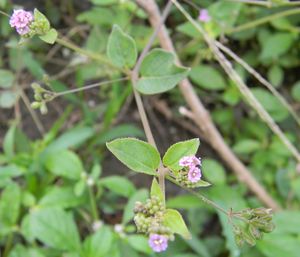Note: This is a project under development. The articles on this wiki are just being initiated and broadly incomplete. You can Help creating new pages.
Boerhavia diffusa - Punarnava
Punarnava is a species of flowering plant in the four o'clock family which is commonly known as punarnava. It is taken in herbal medicine for pain relief and other uses. The leaves of punarnava are often used as a green vegetable in many parts of India.
Uses
obesity, dropsy, blood pressure, gastric disturbances, asthma, jaundice, anascara, anaemia, internal inflammation, indurated liver
Parts Used
Chemical Composition
Major components are sitosterol, esters of sitosterol, punarnavine, boerhaavia acid, boeravinone, palmitic acid and many other compounds[1]
Common names
| Language | Common name |
|---|---|
| Kannada | Komme |
| Hindi | Varshbhu |
| Malayalam | |
| Tamil | |
| Telugu | |
| Marathi | NA |
| Gujarathi | NA |
| Punjabi | NA |
| Kashmiri | NA |
| Sanskrit | |
| English | Red spiderling |
Properties
Reference: Dravya - Substance, Rasa - Taste, Guna - Qualities, Veerya - Potency, Vipaka - Post-digesion effect, Karma - Pharmacological activity, Prabhava - Therepeutics.
Dravya
Rasa
Tikta (Bitter), Kashaya (Astringent), Madhura (Sweet)
Guna
Laghu (Light), Ruksha (Dry)
Veerya
Ushna (Hot)
Vipaka
Katu (Pungent)
Karma
Pitta, Kapha
Prabhava
Habit
Identification
Leaf
| Kind | Shape | Feature |
|---|---|---|
| Simple | Ovate-cordiform | Leaf Arrangement is Opposite |
Flower
| Type | Size | Color and composition | Stamen | More information |
|---|---|---|---|---|
| Unisexual | pink | 5-20 | In terminal or axillary panicles of umbellate or capitate clusters |
Fruit
| Type | Size | Mass | Appearance | Seeds | More information |
|---|---|---|---|---|---|
| club-shaped anthocarp | 7–10 mm (0.28–0.4 in.) long pome | Fruiting throughout the year | With hooked hairs | {{{6}}} |
Other features
List of Ayurvedic medicine in which the herb is used
- Vishatinduka Taila as root juice extract
Where to get the saplings
Mode of Propagation
How to plant/cultivate
Boerhavia diffusa is widespread through much of the tropics and the subtropics and has also become naturalized in parts of the temperate zone Prefers a sunny position and a well-drained soil[3]
Commonly seen growing in areas
Photo Gallery
References
External Links
- Ayurvedic Herbs known to be helpful to treat obesity
- Ayurvedic Herbs known to be helpful to treat dropsy
- Ayurvedic Herbs known to be helpful to treat blood pressure
- Ayurvedic Herbs known to be helpful to treat gastric disturbances
- Ayurvedic Herbs known to be helpful to treat asthma
- Ayurvedic Herbs known to be helpful to treat jaundice
- Ayurvedic Herbs known to be helpful to treat anascara
- Ayurvedic Herbs known to be helpful to treat anaemia
- Ayurvedic Herbs known to be helpful to treat internal inflammation
- Ayurvedic Herbs known to be helpful to treat indurated liver
- Herbs with Roots used in medicine
- Herbs with Seeds used in medicine
- Herbs with Leaves used in medicine
- Herbs with common name in Kannada
- Herbs with common name in Hindi
- Herbs with common name in English
- Habit - Perennial plant
- Index of Plants which can be propagated by Seeds
- Index of Plants which can be propagated by Cuttings
- Herbs that are commonly seen in the region of Open places near the sea
- Herbs that are commonly seen in the region of dry and warm river valleys
- Herbs that are commonly seen in the region of Along roadsides
- Herbs
